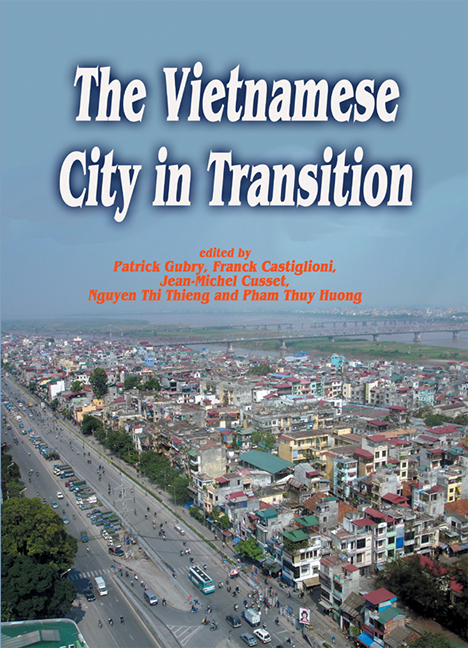Book contents
- Frontmatter
- Contents
- List of Tables
- List of Figures
- List of Colour Plates
- Foreword
- Acknowledgments
- List of Acronyms
- The Editors
- The Contributors
- Introduction: Urban Research in Action: Context, Aims, Directions
- 1 Urban Transition in Vietnam: Its Processes and Stakeholders
- 2 Road System and Urban Recomposition in Hanoi
- 3 Intra-Urban Mobility in Ho Chi Minh City and Hanoi
- 4 Resettlement Issues of Informal Settlement Areas in Ho Chi Minh City: From Large-scale Programmes to Micro-projects
- 5 Changes in Public Water Management: Transition, Compromise, and Innovation
- 6 The Role of Civil Society in Urban Environmental Management
- 7 Assessment of Projects Supported by Official Development Assistance Based on Partnership Formats: From Ho Chi Minh City to Hanoi
- 8 Relations between International Consultants and the Local Engineering Force in Urban Infrastructures
- 9 Conclusion: A Diverse Approach to Research on Urban Issues
- General Bibliography
- Index
- Plate Section
8 - Relations between International Consultants and the Local Engineering Force in Urban Infrastructures
Published online by Cambridge University Press: 21 October 2015
- Frontmatter
- Contents
- List of Tables
- List of Figures
- List of Colour Plates
- Foreword
- Acknowledgments
- List of Acronyms
- The Editors
- The Contributors
- Introduction: Urban Research in Action: Context, Aims, Directions
- 1 Urban Transition in Vietnam: Its Processes and Stakeholders
- 2 Road System and Urban Recomposition in Hanoi
- 3 Intra-Urban Mobility in Ho Chi Minh City and Hanoi
- 4 Resettlement Issues of Informal Settlement Areas in Ho Chi Minh City: From Large-scale Programmes to Micro-projects
- 5 Changes in Public Water Management: Transition, Compromise, and Innovation
- 6 The Role of Civil Society in Urban Environmental Management
- 7 Assessment of Projects Supported by Official Development Assistance Based on Partnership Formats: From Ho Chi Minh City to Hanoi
- 8 Relations between International Consultants and the Local Engineering Force in Urban Infrastructures
- 9 Conclusion: A Diverse Approach to Research on Urban Issues
- General Bibliography
- Index
- Plate Section
Summary
Little research has been carried out on consultancy firms and consultants working in the field of infrastructure and urban technical services in Asia, with the notable exception of Rimmer and Dick's contribution on urban transport in South-East Asia and our own work on the subject (Baye and Cusset 1990; Baye and Lorrain 1997). In the past decade, the context of intervention has become increasingly complex for consultants, for several reasons: the diversification of options associated with a project, whether technological, financial (that is, urban transport infrastructure concession, BOT or “Build-Operate-Transfer”, etc.) or institutional (project management strengthening, establishment of autonomous municipal enterprises, etc.); increased awareness of environmental impacts; the need for consultants to be able to work with representatives of the residents or users (participative pricing). In conjunction with this new configuration, the development of information technology in its widest sense has opened up new possibilities for the modelling, simulation and representation of phenomena (for example, satellite images, databases) by making new or previously unaffordable tools available to small professional engineering firms.
The increased complexity of applied methods might not always have resulted in increased efficiency. However, within a few decades, consultants' professional practice has been altered in such a way that they now occupy an important position within decision-making and innovation processes.
Two concepts are commonly used to describe the role of consultants in the development process. The first describes them as laying the groundwork for exporting equipment; the second concept is more insightful and portrays consultants as a driving force for the development of “models” in countries receiving international aid. Rather than following either of these two concepts, our research — based on cases in Hanoi, Ho Chi Minh City and Phnom Penh — consisted in identifying which foreign consultancy firms were involved in urban infrastructure projects. Our aim was to observe their approach, their relation with project management and the way they were cooperating with the local engineering force, especially in terms of their influence on decision-making. The objective was simple: re-examine the issues surrounding the role of consultants in the urban development process. Our research was not actually restricted to the two Vietnamese metropolises.
- Type
- Chapter
- Information
- The Vietnamese City in Transition , pp. 239 - 270Publisher: ISEAS–Yusof Ishak InstitutePrint publication year: 2010

